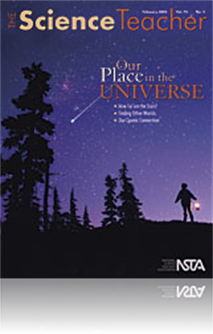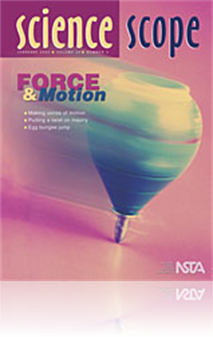All Resources
Journal Article
Science Shorts: Exploring Insect Vision
A fly is buzzing around in the kitchen. You sneak up on it with a flyswatter, but just as you get close to it, it flies away. What makes flies and other insects so good at escaping from danger? The fact that insects have eyesight that can easily det...
Journal Article
Elementary school teachers and university researchers combine their expertise to help students construct an understanding of force—and discover something of the nature of science in the process. Second- and third-grade students in an after school s...
Journal Article
In 2001, the All Sky Camera Network came to life as an outreach program to connect the Denver Museum of Nature and Science (DMNS) exhibit Space Odyssey with Colorado schools. The network is comprised of cameras placed strategically at schools through...
Journal Article
Idea Bank: Classroom Newsletter
Have you ever struggled with trying to motivate your students to learn science? If your answer is a resounding "yes!"-- the implementation of a class newsletter may be the solution. A class newsletter project can improve student self-confidence and m...
Journal Article
Preventing chemical spills in the laboratory is critical, but teachers also need to know what to do if a spill does occur. This article outlines strategies to help with hazardous chemical spills in lab facilities and on people, with a special section...
Journal Article
Tried and True: Newton's first law: A learning cycle approach
Demonstrate how Newton's first law of motion applies to students' everyday lives with this learning cycle series of activities on inertia. This activity is sure to elicit wide-eyed stares and puzzled looks from students, but also promote critical thi...
Journal Article
Since 1995, astronomers have discovered over 100 known exoplanets--planets outside of our solar system--and determined their properties such as mass, orbital distance, size, and density. By using simple algebraic equations of physics, students can de...
Journal Article
Environmental education addresses many aspects of quality learning. It can be local and carry a great meaning to the students. It is always interesting and complex. It is multidisciplinary in the very broadest and deepest ways. It not only stradd...
Journal Article
On any night, the stars seen in the sky can be as close to Earth as a few light-years or as distant as a few thousand light-years. Distances this large are hard to comprehend. In this article, we explore how astronomers measure the distances to stars...
Journal Article
This article chronicles a principal's wish which sparked an environmental education program at his school. The program evolved into a community wide effort which reaches more than 1000 students each year. The program helps teachers incorporate nati...





